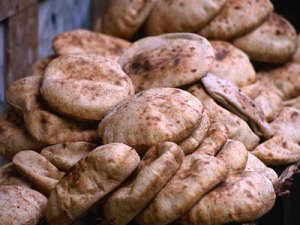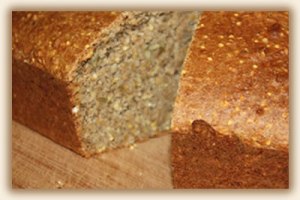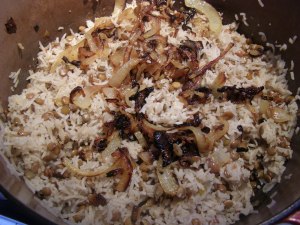The Diet of the Desert
The diet of the Desert Hermits is often shrouded in myth and mystery, and improbable stories of miracles, including claims that some lived without eating (inedia) or only consumed the Eucharist. However, there is now considerable research data available on what the Hermits did, in fact, eat and drink.
The Hermits were almost universally vegetarian (and, often, for practical reasons, vegan) on ascetical principle, but also because of the absence of animals and the lack of means for storing or preserving meat or fish.
The basic principles, which can (and probably should) be applied by contemporary Hermits, were that diet needed to be based on ingredients that were:
• simple – it was not intended to be “gourmet cooking”, nor to require unnecessary expenditure of resources, time or effort in preparation;
• sustainable – any ingredients needed to be able to survive (often for long periods) in the desert without refrigeration, preserving or canning (thus, dried lentils or chickpeas are excellent resources)(although olives might be preserved in oil, or vegetables in brine);
• accessible – ingredients needed to be easily accessible either from the Hermit’s own garden or from local suppliers close-by;
• seasonal – given the lack of means of storage for anything not dry, only seasonal produce could usually be used;
• cheap – Hermits lived with minimal resources and could only buy the cheapest (which also means the best value for money) food;
• nutritious – since Hermits ate frugally (and often infrequently), the diet needed to provide maximum nutrition with minimal quantity and cost (again, lentils are an excellent resource in this regard).
To understand the diet of the Desert Hermits, knowledge of the diet of Egyptian peasants in the early centuries of the Church is essential [see suggested resources below]. This diet, while simple, was not as drab and monotonous as is often assumed. It was primarily vegetarian (and often vegan) but included: bread (thus, flour, leaven, oil, salt); lentils and pulses; seasonal fruit, vegetable and herbs; dates and figs (which can dried) and honey.
Bread was the staple food (as it was throughout the Middle East). This included both Pita Bread, a slightly leavened wheat bread, flat, either round or oval, and variable in size. Its history extends far into antiquity, since flatbreads in general, whether leavened or not, are among the most ancient breads, requiring no oven or utensils to make.

The term used for the bread in English is a loanword from Greek, pita (πίτα), probably derived from the Ancient Greek pēktos (πηκτός), meaning “solid” or “clotted”. In the Arabic world, pita is a foreign word, all breads are called khubz (ordinary bread), and specifically this bread is known as khubz arabi (Arabic bread). The tenth-century Arab cookery book, Kitab al-Tabikh by ibn Sayyar al-Warraq, includes six recipes for khubz, all baked in a tannur oven.
But it is clear that another form of more substantial and solid bread was important: this could be kept for very long periods and be “reconstituted” by the additional of water when it had become too hard to eat by itself. It may have been that this was a form of “Ezekiel Bread” [Ezekiel 4:9], a remarkable bread which not only survives for very long periods, but is nutritionally complete and will supply protein, calcium, phosphorus, iron, sodium, potassium, vitamins A and C, thiamine, riboflavin, and niacin. A variety of recipes for “Ezekiel Bread” can be found on-line.
Most Egyptian bread was made from wheat, and but a variety of other ingredients could be added.
See Bread in Ancient Egypt http://www.touregypt.net/featurestories/bread.htm
Considering popular (without intending the term to be patronizing) peasant food in Egypt from the distant past up to the present suggests what the Desert Hermits probably ate. This food has, looking at the historical record, changed little over the centuries apart from the later inclusion of relatively modern ingredients (for example, tomatoes). Such food almost inevitably included (and includes):
• hummus (Arabic: حُمُّص), a mashed chickpea dip made with tahini, olive oil, garlic and lemon juice;
• tahini (also tehina) (Arabic: طحينه) , a paste made from ground, hulled sesame seeds used in North African, Greek, Turkish and Middle Eastern cuisine;
• falafel (Arabic: فلافل,), fried balls made of chickpeas, onions and spices;
• tabouleh (Arabic: تبولة tabūlah), a salad made of cracked wheat, mint, parsley and other herbs;
• baba ghannouj (Arabic بابا غنوج bābā ghanūj, baba ganush, baba ghannouj or baba ghannoug), a dish of eggplant (aubergine) mashed and mixed with virgin olive oil and various seasonings;
• foul mudammes (Egyptian Arabic: فول مدمّس, IPA: fūl midammis; alternate spellings include ful medames or ful mudammas), or simply fūl), is an Egyptian/Sudanese dish of cooked and mashed fava beans served with olive oil, chopped parsley, onion, garlic, and lemon juice.
Although these specific dishes were probably not used by the Desert Hermits, the culinary principles underlying them are doubtless ancient. For example, foul mudammes is a high protein meal which can use a wide range of ingredients, requires very little preparation, cooks very slowly, and will keep for several days.
A typical Egyptian peasant dish, widely served in Coptic Monasteries (especially in Lent) is Kushari, also koshary, kosheri or koshari (Egyptian Arabic: كشرى, [ˈkoʃæɾi]), is an Egyptian dish of rice, lentils, chickpeas and macaroni topped with tomato sauce and fried onion. Also optionally, with garlic juice. This is (apart from macaroni and tomatoes, which are very much later additions) is a typical Desert dish.
What might be called the “Desert Diet” brings all the benefits of what is now widely known as the “Mediterranean Diet” often cited as beneficial for being low in saturated fat and high in monounsaturated fat and dietary fibre [see http://en.wikipedia.org/wiki/Mediterranean_diet and http://www.mayoclinic.com/health/mediterranean-diet/CL00011 ]. It is high in protein, low in fat, essentially cholesterol free.
It is certainly not necessary to live in the Desert, or in Egypt or in the Middle East, let alone to be a culinary expert to enjoy the Desert Diet. Numerous simple, easy to prepare and cook recipes are readily available on-line and in many books. To the traditional ingredients can readily be added modern, seasonal and locally available produce (like tomatoes).
This food has the additional advantage of usually being able to be kept (even without refrigeration, and even in hot climates) for several days.
Resources:
1. Ancient Egyptian Food
Ancient Egypt: Fruit and Vegetables
http://www.reshafim.org.il/ad/egypt/timelines/topics/vegetables.htm
Food and Drinks in Ancient Egypt
http://www.perankhgroup.com/Food%20and%20Drinks%20in%20Ancient%20Egypt.htm
Ancient Egyptian: Food, Beer and Drink
http://factsanddetails.com/world.php?itemid=1940&subcatid=365
2. The Diet of the Desert Fathers and Mothers
Claudine Dauphin “The Diet of the Desert Fathers in Late Antique Egypt”, “Bulletin of the Anglo-Israel Archaeological Society” 2001–2002 Volumes 19–20
Click to access 746657920,PL,0,0,The-Diet-of-the-Desert-Fathers-in-Late-Antique-Egypt.pdf
Claudine Dauphin “Eucharistic bread or thistles ? Fact or fiction?: the diet of the Desert Fathers in late antique Egypt and Palestine” Trivium Occasional Papers, n°3. Lampeter : Trivium Publications, University of Wales, 2009
Lucien Regnaul “Day-To-Day Lives of the Desert Fathers in Fourth-Century Egypt”
(2000) http://www.amazon.com/Day–Desert-Fathers-Fourth-Century-Egypt/dp/1879007347/ref=sr_1_1?s=books&ie=UTF8&qid=1364798674&sr=1-1
Benedicta Ward “Diet For a Large Soul. What monks meant by fasting, and what they ate when they didn’t.”
http://www.ctlibrary.com/ch/1999/issue64/64h024.html
3. Diet in the Eremitical Tradition
David Grumett “Theology on the Menu: Asceticism, Meat and Christian Diet” (2010) http://www.amazon.com/Theology-Menu-Asceticism-Meat-Christian/dp/0415496837
Andrew Jotischky “A Hermit’s Cookbook: Monks, Food and Fasting in the Middle Ages” (2011) http://www.amazon.com/Hermits-Cookbook-Monks-Fasting-Middle/dp/0826423930





Leave a comment